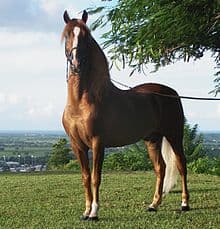Type the name of the breed you're looking for below
[wpdreams_ajaxsearchlite] Don't see the breed your're looking for? Click here and let us know!
Paso Fino
| Country Of Origin | Colombia, Cuba, Dominican Republic, Peru, Puerto Rico |
| History and Background | The Paso Fino name means 'fine step'. The Paso Fino is a blend of the Barb, Spanish Jennet, and Andalusian horse and was bred by Spanish land owners in Puerto Rico and Colombia to be used in the plantations because of their endurance and comfortable ride. All Pasos share their heritage with the Peruvian Paso, the American Mustangs, and other descendants of Colonial Spanish Horses. Puerto Rican and Colombian horses, as well as Paso Finos from Cuba and other tropical countries, have been interbred frequently in the United States to produce the modern American Paso Fino show horse. On the second voyage of Christopher Columbus from Spain to the Americas in 1493, he disembarked with his soldiers, 20 horses and 5 mares on the island of Borinquen at the bay of Aguada (today Añasco), and gave the region the name San Juan Bautista. Soon after, in May 1509, the first governor of the island, Juan Ponce de León, brought horses to Puerto Rico from his hacienda, El Higuey, located on the neighboring island of La Española (now Hispaniola). Puerto Rican Paso Fino Dulce Sueno: The Puerto Rican Paso Fino was developed on the Caribbean island of Puerto Rico over a 500-year colonial period. Island geography and the desires of a people for hardy, sure-footed, comfortable horses led to the independent development of the breed. Frenchman Andres Pedro Ledru, in a notation about horse races held on the 17 of July, 1797, wrote that the speed of these indigenous horses was admirable, "they have no trot or gallop, but a type of pace (Andadura). A gait so precipitated that the eye can't follow the movement of the legs." As early as 1849, Paso Fino competitions were held in Puerto Rico, with prizes for winners, for the purpose of improving local horses. In 1882 the first racetrack was built, and in every race meet, there were Paso Fino and Andadura categories. According to Ramirez de Arellano, when the United States invaded Puerto Rico, the Paso Fino played a first order role in transportation as well as agricultural work. "Manchado," a notable horse of the time owned by Don Nicolás Quiñones Cabezudo of Caguas, was said to be "so fine that it gaited at liberty without its rider in the town square when asked." In 1927 the most influential sire in the modern Puerto Rican Paso Fino breed, Dulce Sueño, was born in Guayama. In 1943, the Federation of the Sport of Paso Fino Horses of Puerto Rico and a breed registry were established. Copita Don Q, a Dulce Sueño grandson, was the winner of the first annual Federation contest in 1943. In an agricultural almanac published in 1947, Gustavo A Ramirez de Arellano wrote, "at present the descendants of the famous stallion "Dulce Sueño" are the ones who have most obtained titles and trophies from the association of owners of saddle horses." Colombian Paso Importation and development in the United States: The rise of the Paso Fino in the United States began in the 1950s and 1960s. The first Paso Finos in the United States were imported by members of the armed services, who purchased the horses while stationed in Puerto Rico. This stock provided some of the first Paso Finos bred in the United States. Colombian Pasos came to the United States beginning with a rancher who visited Colombia and purchased quite a number of the horses to work his cattle. He introduced the second strain into the USA. While the two strains are still bred individually to retain their purity, they are also crossbred to produce the best of both strains. Today, the Paso Fino Horse Association (PFHA) oversees and regulates registered Paso Finos in the USA. It was founded in 1972 under the name "American Paso Finos", later changing to its current name. It registers and promotes both Puerto Rican and Colombian horses, and under the PFHA, the two groups have been frequently crossbred. As the numbers of Colombian horses have begun to significantly outnumber those of Puerto Rican bloodlines, a trend has developed favoring preservation breeding to preserve the bloodlines of each group. The American Trote and Trocha Association formed to promote the horses, primarily of Colombian breeding, that perform a diagonal ambling gait known as the "Trocha". The trocha differs from the classic lateral ambling gait of the Paso Fino. |
| Use Today | Riding horse, cow horse, show horse, endurance horse, parade mount |
| Height | 14 – 15 hands (56 - 60 inches) |
| Colour | All colours |
| Characteristics | The Paso Fino has several different body types, from quite small and refined to very large and powerful. The action of the two strains is somewhat different. The Puerto Rican Paso Fino is prized for its fine or delicate step, while the Colombian Paso Fino tends to have more of a rapid, piston-like action. This is a lively horse that has a natural drive and willingness, known colloquially as "brio", and generally a nice disposition. Paso Finos come in a variety of colors, sizes and body types, but the even four-beat gait and brio are present in all good representatives of the breed. |
| Personality and Temperament | Docile, willing, spirited but gentle |



